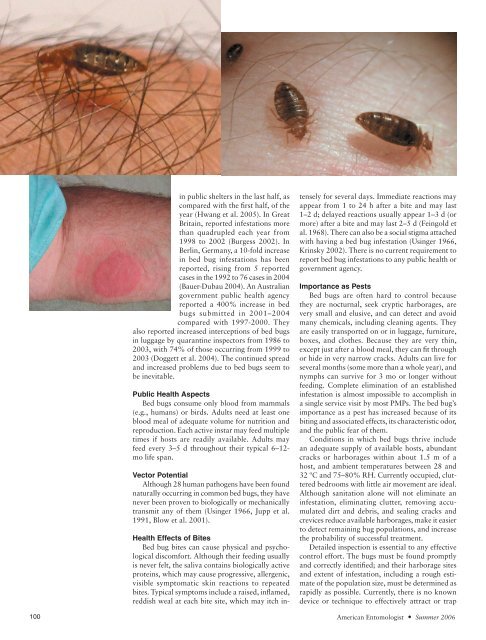Bed Bugs 101: the Basics of Cimex lectularius. - Armed Forces Pest ...
Bed Bugs 101: the Basics of Cimex lectularius. - Armed Forces Pest ...
Bed Bugs 101: the Basics of Cimex lectularius. - Armed Forces Pest ...
- No tags were found...
You also want an ePaper? Increase the reach of your titles
YUMPU automatically turns print PDFs into web optimized ePapers that Google loves.
in public shelters in <strong>the</strong> last half, ascompared with <strong>the</strong> first half, <strong>of</strong> <strong>the</strong>year (Hwang et al. 2005). In GreatBritain, reported infestations morethan quadrupled each year from1998 to 2002 (Burgess 2002). InBerlin, Germany, a 10-fold increasein bed bug infestations has beenreported, rising from 5 reportedcases in <strong>the</strong> 1992 to 76 cases in 2004(Bauer-Dubau 2004). An Australiangovernment public health agencyreported a 400% increase in bedbugs submitted in 2001–2004compared with 1997-2000. Theyalso reported increased interceptions <strong>of</strong> bed bugsin luggage by quarantine inspectors from 1986 to2003, with 74% <strong>of</strong> those occurring from 1999 to2003 (Doggett et al. 2004). The continued spreadand increased problems due to bed bugs seem tobe inevitable.Public Health Aspects<strong>Bed</strong> bugs consume only blood from mammals(e.g., humans) or birds. Adults need at least oneblood meal <strong>of</strong> adequate volume for nutrition andreproduction. Each active instar may feed multipletimes if hosts are readily available. Adults mayfeed every 3–5 d throughout <strong>the</strong>ir typical 6–12-mo life span.Vector PotentialAlthough 28 human pathogens have been foundnaturally occurring in common bed bugs, <strong>the</strong>y havenever been proven to biologically or mechanicallytransmit any <strong>of</strong> <strong>the</strong>m (Usinger 1966, Jupp et al.1991, Blow et al. 2001).Health Effects <strong>of</strong> Bites<strong>Bed</strong> bug bites can cause physical and psychologicaldiscomfort. Although <strong>the</strong>ir feeding usuallyis never felt, <strong>the</strong> saliva contains biologically activeproteins, which may cause progressive, allergenic,visible symptomatic skin reactions to repeatedbites. Typical symptoms include a raised, inflamed,reddish weal at each bite site, which may itch intenselyfor several days. Immediate reactions mayappear from 1 to 24 h after a bite and may last1–2 d; delayed reactions usually appear 1–3 d (ormore) after a bite and may last 2–5 d (Feingold etal. 1968). There can also be a social stigma attachedwith having a bed bug infestation (Usinger 1966,Krinsky 2002). There is no current requirement toreport bed bug infestations to any public health orgovernment agency.Importance as <strong>Pest</strong>s<strong>Bed</strong> bugs are <strong>of</strong>ten hard to control because<strong>the</strong>y are nocturnal, seek cryptic harborages, arevery small and elusive, and can detect and avoidmany chemicals, including cleaning agents. Theyare easily transported on or in luggage, furniture,boxes, and clo<strong>the</strong>s. Because <strong>the</strong>y are very thin,except just after a blood meal, <strong>the</strong>y can fit throughor hide in very narrow cracks. Adults can live forseveral months (some more than a whole year), andnymphs can survive for 3 mo or longer withoutfeeding. Complete elimination <strong>of</strong> an establishedinfestation is almost impossible to accomplish ina single service visit by most PMPs. The bed bug’simportance as a pest has increased because <strong>of</strong> itsbiting and associated effects, its characteristic odor,and <strong>the</strong> public fear <strong>of</strong> <strong>the</strong>m.Conditions in which bed bugs thrive includean adequate supply <strong>of</strong> available hosts, abundantcracks or harborages within about 1.5 m <strong>of</strong> ahost, and ambient temperatures between 28 and32 ºC and 75–80% RH. Currently occupied, clutteredbedrooms with little air movement are ideal.Although sanitation alone will not eliminate aninfestation, eliminating clutter, removing accumulateddirt and debris, and sealing cracks andcrevices reduce available harborages, make it easierto detect remaining bug populations, and increase<strong>the</strong> probability <strong>of</strong> successful treatment.Detailed inspection is essential to any effectivecontrol effort. The bugs must be found promptlyand correctly identified; and <strong>the</strong>ir harborage sitesand extent <strong>of</strong> infestation, including a rough estimate<strong>of</strong> <strong>the</strong> population size, must be determined asrapidly as possible. Currently, <strong>the</strong>re is no knowndevice or technique to effectively attract or trap100 American Entomologist • Summer 2006
















